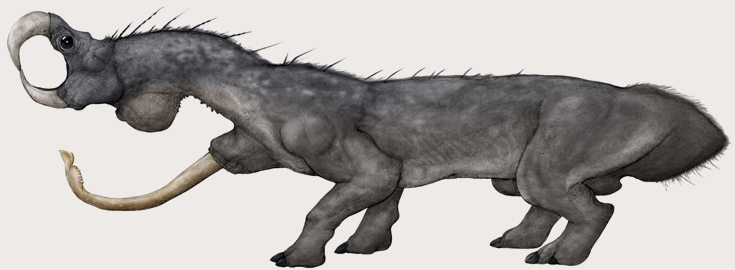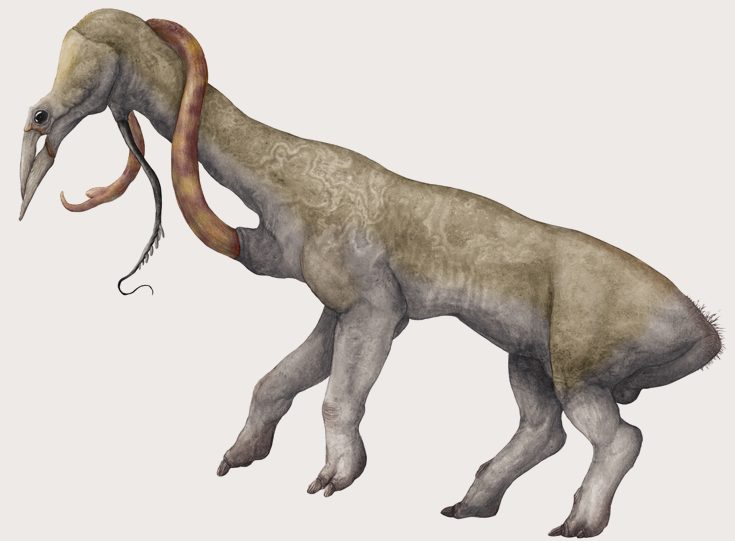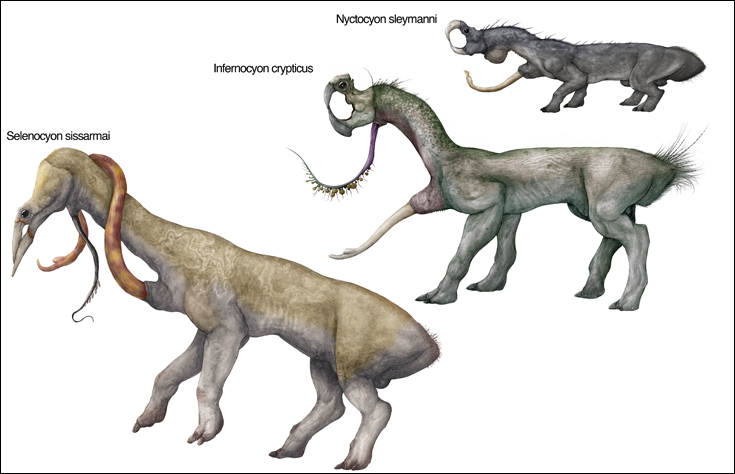Magnopsids
Consisting of a solid, silicate-based lens with no liquid inside, the Snaiadi vertebrate eye bears testament to the complex evolution of life on the planet. Most Snaiadi vertebrates have small, indistinct eyes set in muscular turrets. These organs are almost always surrounded by a complex arrangement of heat receptors that augment their sense of sight at night. As a result, even the nocturnal hunters among the Snaiadi vertebrates have little need for enlarged eyes. The frightening but inoffensive Magnopsids, (along with the unrelated Pudgebears,) form a dazzling exception to this rule.
These animals have no heat receptors on their first heads. Instead, their single-lens eyes have been enlarged to grotesque proportions. These organs work superbly until certain intervals when their outer surfaces are shed to accommodate growth, and “clean up” their line of sight. Most other Snaiadi vertebrates weather this brief episode of cataracts with the help of their heat sensors. Having no heat sensors, the Magnopsids shed their giant eye-lenses in alternating times. Although the animals are still visually impaired during this time, partial blindness is still preferable to a total loss of sight.
Another defining characteristic of this group is their extremely narrow, pincer-like jaws and the enlarged hydraulic muscles that enable them to deliver powerful, snapping bites. Connected to these animals’ specialist diet on small animals, the development of these features has led to a severe remodeling of their first-heads, effectively pushing their genitals outside their first-head jaws. As a result, Magnopsids, especially male ones, look like they have two second heads.
This group originally evolved in the isolated wilderness of Oroland, radiating into a number of different niches, including giant, Kahydron-like predators. With the collision of Oroland with Isterna, their mainland competitors have driven most of these species to extinction. Only three genera and six different species of Magnopsids exist today.

Species: Nyctocyon sleymanni
Common Names: Pincher, Pinchweasel, Suleyman’s Pincher.
Size: Up to 60 centimeters long, usually smaller.
Habitat: A variety of habitats across Orolad, all of Isterna south of the Neomediterranean, and the Pansavannah region of Vesterna.
The three species of Nyctocyon are the only Magnopsid survivors of the Oroland-Isterna population exchange that managed to prosper in the Northern continents. Smart, small and adaptable, they are found in a wide range of habitats across their wide range. These animals are ill-tempered predators that pack an unexpected strength in their strong, pincer-like first-head jaws. Most of their prey consists of smaller animals they dig up from leaf litter or sprog with their long second heads, but on occasion they might attack larger animals such as Chopsticks (Lygodectes sp.) They are also common in the southern Mediterranean cities; entering cities, plantations and even houses in search of food.
Although timid, these animals are related to much larger, extinct forms. Found in the famous Yataan fossil beds in southern Oroland, species such as the four meter-long Murdurognathus show the vanished might of Magnopsid megapredators.
The animal shown here is a female, with its genital bulging with developing young.

Species: Infernocyon crypticus
Common Names: Nightmare Hound, Pinnacle Wraith.
Size: Slightly less than a meter long.
Habitat: Southern Orolandic Pinnacle Range.
This timid hunter of small animals deserves none of its frightening names. Early explorers on Oroland first noticed the presence of Infernocyon though its shrill, stereo screams on dark nights. Later on, the glints of their huge eyes were mistaken for those of much-larger predators. Only when camera traps photographed the first specimens did the legend of gigantic monsters on Oroland truly die down.
Infernocyon spends most of the day hidden in the bases of the characteristically bulging Orolandic pinnacles. With the onset of night it sets out to hunt for small animals in the gallery plains. Phylogenically, Infernocyon and related species represent a more derived lineage of Magnopsids than the archaic Nyctocyon. With legs lengthened for running and more gracile skulls adapted for seizing small prey instead of biting through gristle and hydraulic muscles, they are the among the most harmless and timid of all large Snaiadi predators.
The animal shown here is a male, proudly displaying the branching, multiple-gonad bearing genitals characteristic to Magnopsids.
Species: Selenocyon sissarmai
Common Name: Moon-dog.
Size: 1.2 to 1.5 meters long.
Habitat: Montane forests across the Peaks of Oroland.
This is the largest surviving Magnopsid. Living secluded lives in the thickly forested Peaks of Oroland, these animals subsist on smaller organisms living in leaf litter, or inside trees. These are always captured with a rapid, scissoring snap of their machete-like jaws. Moon dogs also visit forest streams, snapping up the various kinds of Arthrognathan river snakes and bugsalmon that dwell there. On certain nights they might even trace these rivers down into the Orolandic plains, fishing at dark with the night sky reflecting from their enormous, haunting eyes.
These animals are very rare; their population numbers at most at several tens of thousands. Further research is necessary to understand their cryptic lifestyle, and determine if their numbers are increasing or decreasing. It will be a truly saddening loss if these mystifying animals join the long list of spectacular but extinct Magnopsids.
Copyright laws protect all intellectual property associated with Snaiad.
All artwork, concepts and names associated with this project belong to C. M. Kosemen, unless otherwise stated.
